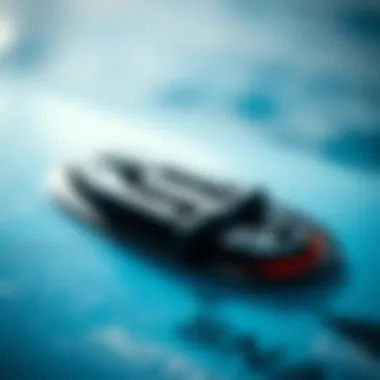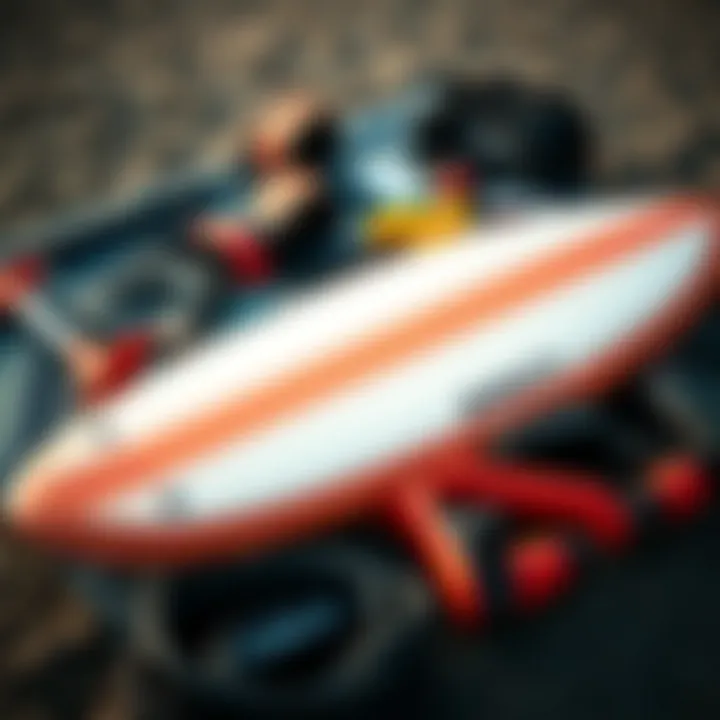Exploring the Dynamics of Hydro Foil Surfboards


Intro
The emergence of hydro foiling has revolutionized water sports, capturing the interest of enthusiasts across the globe. But what exactly is a hydro foil surfboard? At its core, this high-performance board features a submerged wing structure, enabling riders to glide elegantly above the water’s surface. This fascinating design not only reduces drag but also enhances speed and stability, offering a ride unlike any traditional surfboard.
As more kiteboarders, surfers, and water sports aficionados seek out new thrills, understanding the nuances of hydro foiling becomes increasingly relevant. This article guides you through gear selection, skill development, and maintenance considerations, all essential to enhancing your hydro foiling experience. The shift to this innovative riding style promises not just a change in technique but also a fresh perspective on what it means to connect with the waves.
Gear Selection
Types of Kites
Choosing the right kite is like picking the proper fishing rod—each has its own purpose and performance style. Hydro foiling generally calls for specific kite types that incorporate certain features.
- Lightwind Kites: These kites provide ample lift even in low wind conditions, making them ideal for beginners who are just getting the hang of hydro foiling.
- Freeride Kites: These versatile kites balance speed and stability, perfect for those who wish to explore the full potential of hydro foiling.
- Wave Kites: For the adventurous ones wanting to tackle surf conditions, wave kites offer a responsive ride and maneuverability that heightens the hydro foiling experience.
When selecting a kite, note the wind conditions and your personal riding style—this will ensure you are well-equipped for any adventure.
Choosing the Right Board
Your surfboard selection plays an equally critical role in maximizing performance. Hydro foil boards vary greatly in size, shape, and style. Here’s a rundown:
- Board Size: Generally, larger boards are more stable and easier for beginners, while smaller boards offer agility for experienced riders.
- Material: Look for lightweight yet strong materials. Carbon fiber boards are expensive but excellent for performance due to their durability.
- Foil Types: I think it’s beneficial to note the foil’s aspect ratio. A higher aspect ratio means faster speeds, while a lower ratio enables better lift.
In the end, the right board should align with your skill level and riding preferences, setting the stage for a thrilling hydro foiling adventure.
Skill Development
Essential Techniques
With the right gear in hand, it’s time to dive into the waters. Hydro foiling requires specific techniques that differ significantly from traditional surfing. Mastery comes from practice and understanding:
- Takeoff: Start with a steady speed and find the perfect angle to lift off. A smooth and gradual motion will ease you into the ride.
- Balance: As the foil rises, maintain your weight centrally on the board; lean too far back or forward, and you might find yourself taking an unexpected plunge.
- Steering and Control: Use your legs to steer and your body to shift weight. Unlike conventional boards, using your hips more can help you stay stable while making sharp turns.
Progression Tips
Progressing in hydro foiling doesn’t happen overnight, but with determination and practice, anyone can get the hang of it. Here are some handy suggestions:
- Start Small: Focus first on low-speed maneuvers before tackling higher speeds. This builds your confidence.
- Video Reviews: Recording your sessions allows you to analyze your technique, helping identify weaknesses and areas for improvement.
- Community Learning: Engaging with local hydro foiling communities on forums such as Reddit or attending events and meets can accelerate learning. Sharing experiences is invaluable!
Learning to hydro foil might feel daunting at first, but plenty of resources and communities exist to support your journey. Gaining proficiency opens doors to exhilarating experiences you didn’t think possible on water.
Ending
Hydro foiling presents an innovative and exciting challenge for water sport enthusiasts. Understanding the intricacies of gear selection and refining your skills sets you on a path to mastering this exhilarating riding style. By engaging with both the technical aspects and the community around hydro foiling, riders can transform their experiences on the water, making it not just about surfing, but truly flying.
For further exploration of hydro foiling, consider checking out resources like Wikipedia or community insights on Reddit. Happy foiling!
Prolusion to Hydro Foil Surfboarding
Hydro foil surfboarding has carved out a distinctive niche within the broader domain of water sports. As enthusiasts look for new challenges and ways to enhance their experience on the water, hydro foils stand out for their unique combination of technology and environment. This section aims to touch upon the core significance of hydro foil surfing, navigating through what it entails, its history, and why it's becoming a popular choice among surfers, kiteboarders, and water sports aficionados alike.
What is a Hydro Foil Surfboard?
At its core, a hydro foil surfboard integrates a wing-like structure beneath the board that generates lift as the rider glides across the water. This lift allows the board to rise above the surface, decreasing contact with the water and thus reducing drag. Essentially, once you’ve lifted off, you’re cruising through the water more smoothly, which can feel akin to flying. The design typically consists of three parts: the board itself, the foil (which includes the mast, wings, and fuselage), and sometimes a stabilizer for enhanced control.
The concept is simple yet revolutionary; it lets surfers experience the ocean differently, even when the conditions aren’t major. The ability to ride on smaller swells means that riders can explore less crowded waves and enjoy a broader range of surfing locations.
Furthermore, hydro foiling is not just limited to surfing; it's applicable to kiteboarding and paddleboarding too, which opens the doors to all kinds of fun. With the right gear, riders can skim over flat waters or even through choppy conditions, creating a versatile experience that many find exhilarating.
History and Evolution of Hydro Foils
The journey of hydro foils isn't a modern story. It traces back to the mid-20th century when innovative thinkers started experimenting with the idea of reducing drag in watercraft. One of the first instances was in 1963 when a designer named Jim W. W. D. McKee patented a hydrofoil system. Later, in the early 1970s, the surfboard manufacturer called "Cabrinha" started bringing hydro foil technologies to surfing.
The technique began to catch on among niche communities, particularly with those who sought to push the boundaries of what could be done on the water. However, it wasn't until the late 2000s and 2010s that hydro foils truly took off in the surfing world, owing to improvements in materials and design, making them more accessible for the average surfer.


In recent years, the rise of hydro foiling as a mainstream activity can be attributed to a combination of advances in technology and the growing interest in eco-friendly water sports. As hydrodynamic shapes evolve and materials become lighter and stronger, the performance continues to improve, enticing more people to transition from traditional surfboards to hydro foil surfboards.
The prowess of hydro foils is now celebrated with competitions and events specifically dedicated to the discipline, thus marking a pivotal step in the surfing evolution.
"Hydro foiling revolutionizes the way we interact with the ocean, representing both the past and future of water sports."
In summary, hydro foil surfboarding is not just riding a surfboard; it’s a blend of innovation, design, and a fresh approach to an age-old sport. Riders are increasingly drawn to the thrill of slicing through waters, rising above the surface, and discovering the nuances of hydro dynamics. In the following sections, we will explore how hydro foils operate, their components, advantages, and more, setting the stage for a comprehensive understanding of this exciting water sport.
How Hydro Foil Surfboards Work
Understanding how hydro foil surfboards work is essential for anyone looking to master this innovative water sport. The unique mechanics of these boards not only grant riders enhanced performance but also open up new possibilities for fun on the water. By diving into the key functionalities and principles of hydro foiling, enthusiasts can better appreciate its advantages and the skill set required to ride these boards.
The Mechanics of Hydro Foiling
At the basic level, hydro foiling involves a specialized surfboard mounted with a hydrofoil, which usually comprises a mast that extends below the water and a wing that creates lift. As the rider moves forward, water flows over and beneath the wing as it plunges deeper into the water, leading to the generation of lift. The moment lift overcomes gravity, the board rises above the water's surface, allowing the rider to glide without direct contact with the waves.
Key components driving this mechanistic marvel include:
- Foil Configuration: The specifics of the foil, including wing shape and size, greatly influence performance and stability.
- Speed Dynamics: Riders must accelerate to a certain speed for effective lift; you can say it’s all about pedal to the metal.
- Rider Control: Balancing weight and making subtle shifts helps in regulating the height of lift above water and boosting the surfing experience.
By grasping how these elements combine, riders can significantly improve their skills and enjoy the mastery of this sport.
Understanding Lift and Drag
In the world of hydro foiling, lift and drag are two pivotal forces that every rider must comprehend. Lift is what elevates the board, while drag is the resistance that must be countered for a smooth ride.
- Lift: Achieved thanks to the angle of the wing against the water flow, greater angles usually lead to increased lift. This is not unlike how an airplane wing functions, allowing it to glide gracefully through the sky.
- Drag: The less desired force here, drag pulls the board down and slows progress. Managing drag can be likened to maintaining a steady hand while steering a ship through choppy waters.
Riders often seek an ideal balance between lift and drag, as navigating powerful swells or attempting technological tricks demands not just skill but also an understanding of these physical concepts.
This grasp on lift and drag not only facilitates better control but also gives riders insights into tuning their setup for personal preferences.
"Hydro foiling is not just a ride on the water; it’s a dance with nature's forces, where understanding lift and drag turns potential chaos into symphony."
In summary, mastering the mechanics of hydro foiling and comprehending how lift and drag interplay is crucial. It's the backbone of what distinguishes hydro foiling from traditional surfboarding.
This knowledge can set riders on a captivating path toward performance, efficiency, and excitement on the water.
Components of a Hydro Foil Surfboard
Understanding the components of a hydro foil surfboard is crucial for anyone looking to master this invigorating blend of surfing and innovation. Each part plays a pivotal role in the overall performance, stability, and riding experience. By grasping how these elements work together, riders can maximize their fun and effectiveness on the water. The right combination of design, materials, and fin setups can drastically change how a hydro foil performs in various conditions.
Foil Design: Fuselage and Wing
At the heart of a hydro foil surfboard is its foil design, consisting primarily of two main parts: the fuselage and the wing. The fuselage connects the wing to the board and acts as a structural spine. The length and shape of the fuselage can significantly impact stability. A longer fuselage provides a steadier ride, while a shorter one allows for more agility, favoring tricks and maneuvers.
The wing, on the other hand, is where the action truly happens. This element lifts the board above the water, reducing drag and enhancing speed. The shape and size of the wing determine lift characteristics and are often tailored for specific riding styles. For example, a larger wing offers more lift, ideal for beginners or choppy waters, while a smaller wing excels in high-speed conditions for experienced riders. Not to forget, the angle of the wing also plays a critical role in performance. Adjustments to this angle can tweak the ride feel significantly, allowing for a variety of styles and preferences.
Board Construction Materials
The next crucial aspect is the construction materials of the board itself. Hydro foil surfboards are built from a mix of materials designed to balance strength, weight, and durability. Common materials include epoxy composites and carbon fiber. Epoxy boards are typically lighter and offer good flex, making them more buoyant and responsive. Meanwhile, carbon fiber, while often pricier, provides a lightweight solution with superior stiffness and resilience, translating to enhanced performance and longevity on the water.
These materials also influence the overall aesthetics and customization options available to riders. For instance, some makers will incorporate unique graphics or finishes that cater to individual tastes, all while maintaining the functional integrity of the board. So, when selecting a board, consider how these materials not only affect performance but also resonate with your personal style.
Fin Setups and Customization
Lastly, we come to the fin setups and customization options that allow riders to further tailor their hydro foils to their preferred riding style. Generally, hydro foils come with different fin setups, including thruster setups, quad fins, or even single fins, each offering distinct characteristics in terms of grip and maneuverability. Adjusting the fin configuration can provide advantages in specific surfing conditions.
Choosing the right setup enables riders to control their board; for example, a thruster setup might offer more maneuverability, allowing tighter turns, while a quad setup can enhance speed and stability on flat water. Customization via additional fins or different types of foils can also radically alter the ride experience. With the right knowledge, you can dial in your setup, ensuring the hydro foil behaves just as you want it to, whether you're skimming across gentle swells or slicing through more challenging conditions.
"Understanding each component of your hydro foil surfboard is essential to optimizing performance and gaining confidence in your riding. Choose wisely, and you'll find a setup that truly sings for you."
In summary, the interplay of fuselage and wing design, board materials, and fin setups is fundamental in mastering hydro foil surfboarding. Each component offers pathways for increasing performance and personalizing the ride, enabling surfers of all levels—be they mere dabblers or seasoned pros—to find their sweet spot on the waves.
Advantages of Hydro Foil Surfboarding


When it comes to the world of riding waves, hydro foil surfboarding stands out as a game changer. It’s not just about gliding over water; it's about redefining what you can do on a surfboard. The advantages of hydro foil surfboards are numerous and fundamentally improve the overall experience for riders, drawing in both newcomers and seasoned pros alike.
Enhanced Performance and Speed
The crown jewel of hydro foiling is undoubtedly the enhanced performance it offers. Unlike traditional surfboards that sit atop the water, hydro foils lift above it, reducing drag and allowing for higher speeds. This unique feature lets riders pick up pace with just a subtle push from the waves. There's a sense of freedom in feeling the board take off.
- Speed: Riders often notice that their average speed increases significantly. What is thrilling is that even smaller swells can push a hydro foil surfboard to surprising velocities.
- Versatility: Riders can experiment with various maneuvers at impressive speeds, making the sport a delightful adventure.
- Efficiency: With less energy spent combating the resistance of water, energy management becomes more efficient, meaning you can ride longer without exhausting yourself.
Riding in Smaller Waves
In contrast to traditional surfing where larger waves are often sought after, hydro foil surfboarding opens up a whole new world: riding in smaller waves. The board's design allows it to thrive when other surfers might struggle.
- Accessibility: This means that places where conditions might deter regular surfers become playgrounds for foil surfers. You don’t need to wait for those perfect, monster swells.
- Extended Season: The ability to ride in marginal conditions can lead to extended seasons for hydro foiling enthusiasts.
- Skill Development: Small waves sharpen skills like balance and control, giving riders the tools they need for progressing to larger waves when the time is right.
Reduced Water Resistance
One of the unsung benefits of hydro foiling is the significant reduction in water resistance. The way hydro foils function allows for an incredible lift where the board barely scrapes the surface. This shift not only makes for a smoother ride but also translates to several key benefits:
- Less Fatigue: Riders can experience less fatigue over time; it feels lighter underfoot since the board isn’t fighting against the water’s surface.
- Easier Turns: The reduction in resistance makes sharp turns and quick movements more manageable, allowing for a more dynamic surfing experience.
- Smooth Ride: With this decreased resistance, the ride becomes remarkably tranquil. Choppy water feels less jarring, enhancing the enjoyment of the sport.
"Hydro foiling offers the thrill of surfing without the constant struggle against water. It’s like flying on the ocean."
As we can clearly see, the advantages of hydro foil surfboarding not only elevate the riding experience but also invite a wider range of conditions and styles to be explored. Embracing these advantages can lead to a deeper appreciation of both the sport and the natural elements at play, making every surf a memorable journey.
Challenges and Considerations
Navigating the realm of hydro foil surfboards isn't all waves and sunshine; there are notable challenges and considerations that potential riders must contend with. Acknowledging these factors can significantly enhance the overall enjoyment and safety of your hydro foiling experience. By delving into the learning curve and requisite skill development as well as safe practices, we shine a light on the trials riders may face and how to tackle them head-on.
Learning Curve and Skill Development
When it comes to hydro foiling, one fact stands out starkly: mastering the art of gliding above the water's surface is not a walk in the park. Many newcomers find themselves grappling with the mechanics of balancing and steering, often resulting in environment frustration at first.
Unlike traditional surfing, where paddling and catching waves is fundamental, hydro foiling requires a different set of skills altogether. Riders must cultivate an acute awareness of body positioning and balance, which can take time and practice. Those who approach this with an open mind can expect the learning curve to be steep but ultimately rewarding. It’s akin to learning to walk all over again—once you find your footing, the experience is exhilarating.
While practice is paramount, investing in proper instruction can smooth out the learning process. Classes offered by experienced instructors are invaluable. Instructors not only demonstrate techniques but also highlight common pitfalls to avoid, allowing riders to progress more quickly and confidently.
Safety Measures and Risks
Safety is not something to take lightly in the hydro foiling sport. As this water activity has its own unique set of risks, thorough understanding and precautionary measures are a must.
- Wearing a Suitable Wetsuit: Waterproof gear, especially with padding, reduces the likelihood of injuries from falls. A durable wetsuit can keep you warm in cooler waters and also cushions the impact as you tumble into the drink.
- Investing in Proper Safety Gear: Helmets and impact vests may not be fashion statements, but they can save lives. Falling from a height above the water while foiling can lead to injuries if not properly equipped.
- Knowing Your Limits: This is perhaps the golden rule of hydro foiling. Beginners should not attempt to ride in heavy surf or strong currents until they're completely confident in their abilities. Stick to calmer waters until you build your skill set.
- Awareness of Surroundings: Hydro responding to surplus gear, other water users, or changing weather conditions is imperative. Keep an eye out for swimmers, boats, and other surfers—situational awareness is key to ensuring that the sport remains safe for everyone.
"Preparation meets opportunity—being well-prepared can make the difference between an awe-inspiring ride and a tough day on the water."
Choosing the Right Hydro Foil Surfboard
When it comes to hydro foiling, picking the right surfboard can make or break your experience. Why? Because each rider has a unique style and skill level. The right board can boost your confidence and help you progress faster than you might think. Not all boards are created equal, and understanding the nuances can save you from a bad investment.
That said, let's unpack some specific elements that influence the decision-making process when you're on the hunt for the ideal hydro foil surfboard.
Factors to Consider
- Skill Level: If you are just starting out, a board that offers stability is essential. Look for wider models; they provide better balance. On the flip side, experienced riders might prefer narrower boards for agility and speed.
- Weight Capacity: Each board comes with a recommended weight range. Ignoring this could mean not getting the performance you desire. Those who are heavier need to choose boards with more volume or surface area to ensure they can catch enough lift.
- Foil Height and Shape: This is where it gets interesting. A lower foil can be great for beginners since it provides more stability. Advanced surfers, however, might go for higher foils that allow for quicker maneuvers.
- Fin Configurations: This affects how your board feels and reacts in the water. Some boards come with thruster setups while others have quad fins. Testing different setups can drastically change your riding experience, so keep this in mind.
- Material and Build Quality: Hydro foils experience a lot of stress; having a sturdy construction matters. Look for boards made from high-quality materials like carbon fiber or reinforced plastics. These tend to withstand the rigors of hydro foiling better compared to entry-level options.
In essence, don’t skimp on the details. An informed decision can lead to years of enjoyable riding.
Popular Brands and Models
Now that we have established what to consider, let’s dive into some brands and models that have garnered a reputation in the hydro foiling community.
- Slingshot: Known for their robust designs and user-friendly boards, Slingshot is a fantastic choice for newcomers and pros alike. Models like the Slingshot Infinity make a strong case with their versatility.
- Lift Foils: If you're all about innovation, Lift is your go-to. Their boards come with advanced features and an excellent lift-to-drag ratio, perfect for riders aiming to push performance boundaries.
- Fanatic: This brand offers a balance between cutting-edge tech and solid construction. Their boards are known for their stability, making them a popular pick among riders of diverse backgrounds.
- Naish: With a long history in water sports, Naish provides a range of boards that cater to different skills. The Naish Hover is particularly popular, known for its maneuverability and ease of use.
- NSP: For those hesitant to make a big leap in investment, NSP offers budget-friendly options that still perform decently on the water. Their models are often seen as optimal for beginners, aiding comfort and confidence.
Remember, it’s wise to test out boards before you purchase. A demo can give you a feel of what suits your style.


"Choosing the right hydro foil is like finding the right partner; it has to align with your values and enhance your journey."
Navigating the options available can be overwhelming, but keeping these factors and brands in mind can lead to informed decisions. Happy foiling!
Maintenance of Hydro Foil Surfboards
Maintaining your hydro foil surfboard isn't just a matter of keeping it looking good; it’s crucial for performance and safety. Hydro foils represent a significant investment, both financially and in terms of time spent mastering their unique riding technique. When you care for your board properly, you enhance its longevity, ensure reliable performance, and ultimately elevate your riding experience.
Regular maintenance can also prevent costly repairs down the line, especially as saltwater and sand can wreak havoc on delicate components. Investing a bit of time periodically can go a long way in terms of maximizing your fun on the water.
Regular Care and Upkeep
Caring for your hydro foil surfboard involves several basic practices that keep your board in top-notch condition. Here are the primary ones:
- Rinse After Use: Always rinse your board and foil with fresh water after every session, especially after riding in saltwater. Salt can corrode metal parts and degrade other materials over time.
- Dry Thoroughly: Wipe your board down with a soft cloth to remove any remaining water and moisture. This step can prevent mildew and mold from developing in less frequently used parts of the board like the waterproof compartments.
- Inspect Regularly: Check foils, wings, and screws for any signs of wear or rust. A cracked wing or loose screw can affect your performance and might even pose safety risks. Replace or tighten as necessary.
- Professional Servicing: Depending on how often you ride, consider a professional tune-up annually. They can give your equipment a thorough check-up and fix touch points that might go unnoticed during casual inspections.
Regular upkeep of your hydro foil surfboard creates a smoother ride and preserves its aesthetic appeal. Just like a well-tended engine, a delightful ride experience is often supported by thorough maintenance.
Storing Your Hydro Foil
Proper storage is equally as important as maintenance. If you just throw your hydro foil surfboard into the corner of your garage, you may find it less than usable for your next outing. Here are some tips for sensible storage:
- Climate-Controlled Environment: Store your board indoors in a cool, dry place. Temperature extremes can warp materials and degrade epoxy finishes.
- Foil Separation: When storing, separate your foil from the board whenever possible. This avoids any unwanted pressure on the foil surface and prevents accidental damage.
- Use Board Bags: Invest in a quality padded board bag to protect your hydro foil from scratches and impacts during transport and storage. A good bag won’t just keep it safe but also prevent dust or moisture buildup.
- Avoid Direct Sunlight: Prolonged exposure to UV rays can fade colors and weaken the structural integrity of your board. Store the board out of direct sunlight or use a cover.
Storing your hydro foil surfboard with care speaks volumes about your dedication to the sport. Just as a classic car deserves a protective garage, so too does your board deserve proper pampering.
"An ounce of prevention is worth a pound of cure."
This age-old saying rings particularly true for hydro foil surfboards. With the right maintenance and storage strategies, your passion for hydro foiling can continue to thrive for years to come.
Hydro Foiling Versus Traditional Surfing
The discussion around hydro foiling compared to traditional surfing is a pivotal one for enthusiasts and pros alike. Hydro foiling introduces a fresh dynamic to the surfing experience, offering distinct advantages that appeal to those keen on exploring new frontiers in water sports. It is important to comprehend how these two surfing styles differ, especially concerning adaptability, performance, and community impact.
Comparative Riding Experiences
When it comes to riding experiences, hydro foiling and traditional surfing have their unique flavors. Traditional surfing, rooted deeply in the ocean's rhythm, provides a raw connection to the waves. Surfers feel every swell and drop, which brings an exciting sense of unpredictability. The approach is often about mastering the wave itself, adjusting stances, and timing one's ride instinctively.
In contrast, hydro foiling transforms the riding experience into something almost ethereal. Surfers glide effortlessly above the water's surface, detached from the turbulence below. When lifted, the sensation can be akin to flying, as the board harnesses the lift generated by the submerged wings. This altered interaction opens up opportunities for more speed and maneuverability, especially in smaller waves, where traditional surfboards might struggle. Riders often describe the feeling as exhilarating, highlighting the reduced impact of choppy waters on their performance.
Cultural Shifts in Surfing Communities
As hydro foiling gains momentum, there's also a notable cultural shift within surfing communities. The introduction of hydro foil surfboards has sparked conversations and debates among traditional surfers. Some embrace the innovation, viewing it as an exciting evolution of the sport. Other seasoned riders might express skepticism. They argue that hydro foiling alters the very essence of surfing, separating it from the foundational skills of wave riding.
This shift leads to a diversification of the community itself. Hydro foiling attracts not just traditional surfers but also kiteboarders and windsurfers looking to diversify their skills on the water. The melding of these communities can foster collaboration, inspire new techniques, and even modify the very vocabulary of surfing.
"The ocean doesn’t care how you surf. It just cares that you’re out there, enjoying the ride."
In addition, competitions are evolving. Hydro foil surfboard contests are carving out a niche, often set in smaller, more challenging conditions where traditional surfing might not thrive. As such, the dynamics at play are continually changing, presenting thrilling new spectacles for spectators and participants alike.
In summary, the discourse surrounding hydro foiling versus traditional surfing is not just about mechanics; it’s about fundamentally different experiences and the evolving culture within the surfing community. To navigate these waters, riders need to consider their preferences and openness to change while also respecting the rich history of traditional surfing.
Finale
As we reach the end of this exploration of hydro foil surfboarding, it's important to reflect on the significance of what we've discussed. This innovative approach to surfing offers a wealth of benefits, from enhanced speed and agility on the water to the ability to ride smaller, less powerful waves. Each aspect of hydro foiling, be it its mechanics or components, reveals how it redefines the water sports experience.
The Future of Hydro Foil Surfboarding
The future of hydro foiling looks promising. With growing interest among enthusiasts and developments in materials technology, surfboards are becoming more lightweight and responsive. This creates opportunities for new designs that cater to various skill levels, making the sport accessible for beginners while still providing challenges for seasoned riders.
Among the evolving innovations, there is the potential for electric-assisted hydro foils. These boards can help riders get up on foils more easily, especially in flat water conditions, expanding the reach of hydro foiling even further. Such advancements attract a wider audience beyond traditional surfers and kiteboarders, appealing to a new generation of water sports enthusiasts.
- Key Aspects for Consideration:
- Improved board designs to enhance performance
- Development of eco-friendly materials
- Growth in community and competitions fostering skills and techniques
It might be safe to say that hydro foiling is not just a passing trend, but rather a significant development in surfing history. As more individuals venture into hydro foiling, sharing experiences, knowledge, and techniques will be vital to foster a welcoming community. Moreover, education about safety measures remains paramount, ensuring that all riders can enjoy the thrill of hydro foiling while minimizing risks.
Hydro foiling is transforming the way we encounter waves, elevating the sport to new heights – literally!
The sport's cultural impact can’t be underestimated, as it continues to influence global surf communities. In summary, the continued evolution of hydro foil surfboarding presents exciting opportunities, and staying informed will be key for both novices and seasoned riders alike. This article aimed to serve as a comprehensive guide to understanding and embracing this captivating aspect of water sports, while also providing practical advice for all who wish to ride the waves with wings.















